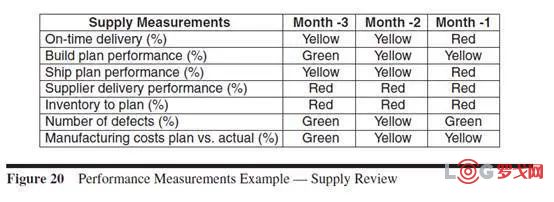

 [羅戈導讀]S&OP經典書籍連載:企業銷售與運營計劃(24)【第五章:S&OP評審會議(3)-RCCP
[羅戈導讀]S&OP經典書籍連載:企業銷售與運營計劃(24)【第五章:S&OP評審會議(3)-RCCP

He advances the computer presentation to the next slide (Figure 20). “Here’s an example of a performance measurement review format,” he says. “Just like the sales and operations planning dashboard, shown earlier in the morning, a green, yellow, and red system is employed to show performance at a glance.”
他將計算機演示推進到下一張幻燈片(圖20)。他說:“這是一個績效衡量審查格式的例子。”“就像早上早些時候顯示的銷售和運營計劃儀表盤一樣,使用綠色、黃色和紅色系統來一目了然地顯示績效。”

Nolan continues to explore the supply review subprocess. He tells the group that the performance review is followed by a review of the newly updated demand plan, or request for product. The purpose of this review is to determine whether the supply side of the business can support the changes in the demand plan and still maintain current resources and projected costs. A simulation of capacity, called rough-cut capacity planning, is commonly used to determine Feasibility.
諾蘭繼續探索供應審查子流程。他告訴小組,績效評估之后是對最新更新的需求計劃或產品需求的評估。本次審查的目的是確定企業的供應側是否能夠支持需求計劃的變更,并仍然保持現有資源和預計成本。產能模擬通常被稱為粗略產能規劃,用于確定可行性。
Nolan is quick to point out that rough-cut capacity planning is different from detailed capacity planning. Rough-cut capacity planning is known as a “first cut” at attempting to answer some questions: Do we have a reasonable chance to support the demand plan? Do we have sufficient resources to support the plan? Are our resources “sized” correctly? If the answer to any of these questions is no, the supply team is responsible for taking action or making recommendations to take action to solve the out-of-balance condition.
諾蘭很快指出,粗略的產能規劃不同于詳細的產能規劃。在試圖回答一些問題時,粗略的產能規劃被稱為“第一次削減”:我們是否有合理的機會支持需求計劃?我們有足夠的資源支持這項計劃嗎?我們的資源“規模”是否正確?如果這些問題的答案為“否”,則供應團隊負責采取行動或提出建議,采取行動解決失衡狀況。
“In essence, rough-cut capacity planning is a ‘what if’ simulation that tests whether you can commit to support the new demand plan without changing one of the knobs we talked about before,” Nolan says.
諾蘭說:“本質上,粗略的產能規劃是一個假設模擬,它測試你是否可以承諾支持新的需求計劃,而不改變我們之前討論過的一個旋鈕。”
“When you use the term rough-cut capacity planning, are suppliers included in the simulation?” Anita Cooper, the purchasing manager, asks. Nolan asks the group to turn to page 47 in their notebooks, which provides more details about rough-cut capacity planning. He explains that it is imperative to have the ability to perform multiple simulations quickly and easily. There are usually multiple planning options, and it is frequently desirable to test more than one production/supply plan alternative against the demand request for product. Another principle of rough-cut capacity planning is the simulation of key resources only. “Not all resources are simulated,” Nolan says. “Just the ones that are likely to cause problems.”
“使用“粗略產能規劃”一詞時,模擬中是否包括供應商?”采購經理安妮塔·庫珀問道。諾蘭要求小組翻到他們筆記本中的第47頁,該頁提供了關于粗略產能規劃的更多細節。他解釋說,必須具備快速、輕松地執行多個模擬的能力。通常有多個計劃選項,通常需要針對產品的需求請求測試多個生產/供應計劃備選方案。粗略產能規劃的另一個原則是只模擬關鍵資源。“并不是所有的資源都是模擬的,”諾蘭說。“只有那些可能引起問題的人。”
He tells the group that key resources typically are bottlenecks or constraints. They may be resources that are difficult or expensive to change. He goes on to list typical categories of key resources: skills, materials, engineering, money, or any other item that may be a constraint in supporting the new demand request. “And, yes, Susan,” Nolan says, “they may include key suppliers as well as internal resources. Additionally, the key constraints may actually be key materials. These can be simulated as well as capacity.”
他告訴小組關鍵資源通常是瓶頸或約束。它們可能是難以改變或代價高昂的資源。他接著列出了關鍵資源的典型類別:技能、材料、工程、資金,或任何其他在支持新需求請求方面可能受到限制的項目。“是的,蘇珊,”諾蘭說,“他們可能包括關鍵供應商和內部資源。此外,關鍵約束實際上可能是關鍵材料。這些可以模擬,也可以模擬容量。”
Nolan explains that the objective is to first identify any constraints so that alternative approaches can be developed to support the demand. It would be unusual to find that all resources are constraints. Depending upon the volume and the product mix, it is typical to find a limited number of constraints during any particular period in time.
諾蘭解釋說,目標是首先確定任何的限制條件,以便開發替代方法來支持需求。很難發現所有資源都是約束條件。根據產量和產品組合,通常在任何特定時間段內找到有限數量的限制條件。
“Remember,” Nolan says, “in a demand-driven organization with the objective to meet customers’ expectations all the time, you should be predisposed to find a way to say yes to the new demand request for product. If it costs more to do so, the implications of supporting the plan should surface as a management issue in the sales and operations planning process. The cost of not meeting marketplace expectations may ultimately be far greater than the added cost to manufacturing or engineering.”
“記住,”諾蘭說,“在一個以滿足客戶期望為目標的需求驅動型組織中,你應該傾向于找到一種方法來對產品的新需求請求表示同意。如果這樣做的成本更高,支持計劃的影響應該在銷售和運營計劃過程中作為管理問題顯現出來。不滿足市場預期的成本最終可能遠遠高于制造或工程的附加成本。”
Susan raises her hand. “If this is only rough-cut capacity planning, when is more detailed capacity planning performed?” Nolan tells the group the detailed capacity planning is usually performed as part of the master scheduling process. The additional detail simulated typically includes testing resources for an expanded number of variables, including product mix, a more detailed simulation of resources, and specific days or weeks. Detailed capacity planning is commonly performed more frequently than once a month, usually weekly or sometimes even daily.
蘇珊舉起手來。“如果這只是粗略的產能規劃,那么何時執行更詳細的產能規劃?“諾蘭告訴小組詳細的產能計劃通常作為主計劃流程的一部分執行。模擬的額外細節通常包括擴展變量數量的測試資源,包括產品組合、更詳細的資源模擬以及特定的天數或周數。細產能規劃通常每月執行一次以上,通常每周甚至每天執行一次。
Nolan stops and surveys the room. He wants to make sure that the group understands the differences between rough-cut capacity planning and detailed capacity planning. He explains that for sales and operations planning, rough-cut capacity planning is performed monthly and at an aggregate level. For example, rough-cut capacity planning may simulate the demand of all product groups for the capacity of an entire work center, which may consist of three machines. In contrast, detailed capacity planning may simulate each machine in that same work center.
諾蘭停下來等問題。他希望確保小組了解粗產能規劃和細產能規劃之間的差異。他解釋說,對于銷售和運營計劃,粗略的產能計劃每月執行一次,并在總水平上執行。例如,粗略的產能規劃可以模擬所有產品組對整個工作中心產能的需求,該工作中心可能由三臺機器組成。相反,細產能規劃可以模擬同一個工作中心中的每臺機器。
Nolan clicks the mouse to advance to the next slide (Figure 21). “Here is an example of a rough-cut capacity planning presentation for one resource,” he says. The vertical columns represent requirements for the capacity in time periods. The bottom line represents demonstrated capacity. The middle line represents planned capacity, and the top line represents maximum capacity. Nolan
單擊鼠標前進到下一張幻燈片(圖21)。他說:“這是一個針對一種資源的粗產能規劃演示的例子。”垂直列表示時間段內的容量要求。底線代表展示的能力。中間一行表示計劃的能力,頂一行表示最大容量。

The power of rough-cut capacity planning is its ability to demonstrate whether the resources are ‘sized’ correctly to support what we chose to do in the marketplace,”
“粗略的產能規劃的作用在于,它能夠證明資源規模是否正確,以支持我們在市場上選擇的做法。”
Nolan comments. “It not only identifies problems of projected capability shortages, but it also identifies opportunities where there is projected capacity available. For master scheduling, additional detailed capacity simulations may be required to ensure that the detailed schedule is feasible and can be supported by the company resources.”
諾蘭評論。“它不僅搞清了預測能力短缺的問題,而且還搞清了存在預測能力可用的機會。對于主計劃,可能需要進行額外的細產能模擬,以確保詳細計劃可行,并得到公司資源的支持。”
Nolan looks at Jim, Guy, and Susan. He tells them that two books are required reading: Gaining Control by James Correll and Norris Edson and Master Scheduling by John Proud.
諾蘭看著吉姆、蓋伊和蘇珊。他告訴他們要閱讀兩本書:由詹姆斯·科雷爾和諾里斯·埃德森寫的《獲得控制》,約翰·普勞德寫的《主排產計劃》。
Jim Simpson raises his hand. “What about inventory and customer lead times? Are they considered in the supply planning process?”
吉姆·辛普森舉起手來。“庫存和客戶交貨時間怎么辦?在供應計劃過程中是否考慮這些因素?“
“Yes, they are,” Nolan replies. “In previous sales and operations planning cycles, you will set targets for inventory and customer lead times by product line or product group. The demand planning process could request changes in those targets along with their updated demand plan, or request for product. The load on key resources includes meeting inventory and lead time targets.”
“要,是要考慮的,”諾蘭回答。“在以前的銷售和運營計劃周期中,將按產品線或產品組設置庫存和客戶交貨期的目標。需求計劃過程可以請求更改這些目標及其更新的需求計劃,或者請求產品。關鍵資源的負擔包括滿足庫存和交貨期目標。”
He explains that in response to requests for changes in inventory and lead time targets as well as the updated demand plan, the supply organization develops a volume production plan by month. This plan should (1) satisfy customer delivery requirements, or shipments; (2) conform as closely as possible to inventory targets; and (3) meet as closely as possible customer lead-time targets. To achieve all three aims requires tactics that address how much inventory is required to support the desired customer lead-time targets. “The process for determining these tactics frequently is called ‘where to meet the customer,’” Nolan says.
他解釋說,為了響應庫存和交貨期目標以及更新的需求計劃的變更要求,供應部門按月制定批量生產計劃。該計劃應(1)滿足客戶交貨要求或出貨;(2)盡可能接近庫存目標;(3)盡可能接近客戶交貨期目標。要實現這三個目標,需要策略來解決支持所需客戶提前期目標所需的庫存量。諾蘭說:“確定這些策略的過程經常被稱為‘在哪里會見客戶’。”
He further explains that determining the tactics is a key element of implementing a combined marketing–manufacturing strategy. It also is necessary for effective master scheduling.
他進一步解釋說,確定策略是實施聯合營銷-制造戰略的關鍵要素。有效的主調度也是必要的。
“This could be the subject of another class,” Nolan tells the group, “and we will have much discussion on inventory and lead time tactics as we work with you to develop your sales and operations planning process. For now, let’s just acknowledge that we must decide what our tactics will be and set targets accordingly.”
“這可能是另一個課程的主題,”諾蘭告訴小組,“在我們與你們合作開發銷售和運營計劃流程時,我們將對庫存和交貨期策略進行大量討論。現在,我們承認,我們必須決定我們的戰術,并相應地設定目標。”
Susan raises her hand. “Before we move on, doesn’t this whole conversation imply that the production plan could be different from the backlog of customer orders? Also, couldn’t the production plan be different from what is planned to be sold?”
蘇珊舉起手來。“在我們繼續之前,整個對話是否意味著生產計劃可能與客戶訂單積壓有所不同?另外,生產計劃和銷售計劃有什么不同嗎?”
Mark admires Susan’s approach. She already knows the answers to the questions she has asked, but she wants everyone else to hear the answers from an industry expert. She has some points to make, and she is going to let Nolan make them for her. “You’re correct, Susan,” Nolan replies. “We call it the decoupling of demand and supply.” He explains that, stated simply, decoupling of demand and supply involves choosing to produce at a rate different than the shipment rate or the bookings rate. To the extent that these rates are different, either inventory or customer lead time (backlog), or both, will need to be varied.
馬克贊賞蘇珊的舉動。她已經知道了她所問問題的答案,但她希望其他人都能聽到一位行業專家的答案。她有一些要點要講,她要讓諾蘭為她講。“你說得對,蘇珊,”諾蘭回答。“我們稱之為供需分離。”他解釋說,簡單地說,供需分離涉及選擇以不同于出貨率或預訂率的速度生產。如果這些比率不同,庫存或客戶提前期(積壓)或兩者都需要改變。
“The principle of decoupling demand and supply gives the supply side of the business improved control over two of the three knobs — the time knob, or schedule, and the resource knob, or people, equipment, etc.,” Nolan says. “Even though the production plan is different from the customer order backlog when demand and supply are decoupled, the production plan still must support current orders on the books, or backlog, and the anticipated demand.”
諾蘭說:“將需求和供應分離的原則使企業的供應部門能夠更好地控制三個旋鈕中的兩個——時間旋鈕或者說時間表,以及資源旋鈕,或者人、設備等。”“即使生產計劃不同于需求和供應分離時的客戶訂單積壓,生產計劃仍然必須支持帳面上的當前訂單或積壓以及預期需求。”
Nolan displays the next slide in his presentation (Figure 22). He asks the group to consider the point made by the graphic. It is a reality that demand fluctuates. It is also a reality that a level production schedule is most cost effective. Decoupling demand and supply enables companies not to force demand to conform to a level production schedule. It also gives the manufacturing function the ability to produce more cost effectively.
諾蘭在他的PPT中放了下一張幻燈片(圖22)。他要求小組考慮圖片中的重點。需求波動是現實。事實上,水平生產計劃最具成本效益。將需求和供應分離使企業不必強迫需求符合水平生產計劃。它還為制造功能提供了更具成本效益的生產能力。



前海粵十完成新一輪戰略融資
2363 閱讀
樂歌股份預計2024年歸母凈利潤下降約50%,大力發展海外倉
2332 閱讀
連續5年的“春節主力軍”,德邦為何如此穩?
1695 閱讀AI改變物流業的游戲規則:從炒作到實踐的深度思考
1283 閱讀CES 2025:NVIDIA OMNIVERSE驅動的智能倉儲數字孿生革命
1245 閱讀制造業企業,不要逼物流公司降價了!
1152 閱讀拼多多引領電商西進:帝王蟹進村,非遺剪紙出山
1157 閱讀2024年12月份中國出口集裝箱運輸市場分析報告
1104 閱讀菜鳥拆分為假消息,繼續大力發展全球物流業務
1078 閱讀全球海運市場動態(一月中旬至一月下旬)
1028 閱讀